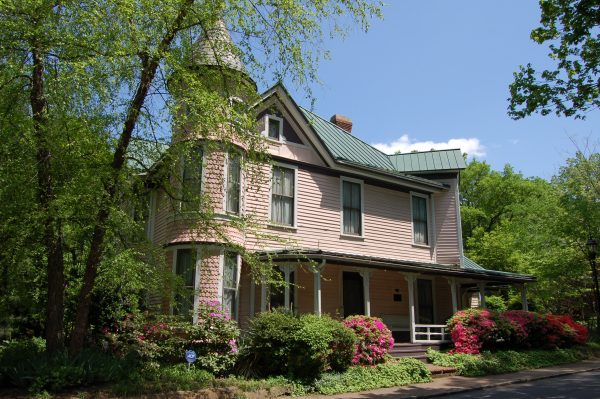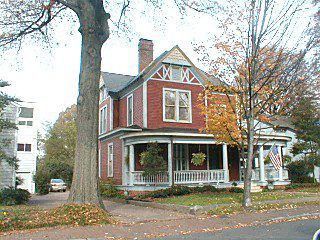Ever wondered … what’s the oldest building in uptown Charlotte?

Ever wondered … what’s the oldest building in uptown Charlotte?
If one were to compare the Charlotte skyline of 1975 with today’s, the city would be almost unrecognizable. Charlotte’s exponential growth over the past 40 years has produced a city much different in size and shape than even 20 years ago. But in creating this newer city, we have destroyed much of the old. While old farmsteads dating to the late 1700s can still be found around Mecklenburg County, uptown Charlotte is almost completely bereft of any building over 100 years old.
In Mecklenburg County, the oldest home is the Hezekiah Alexander House, built in 1774. A well-built house of rocks, it’s open for tours at the Charlotte Museum of History. Yet in 1774 it was well outside Charlotte town limits in 1774. I wanted to know: What historic buildings have remained in uptown Charlotte? 
The “winner” is the Lyles-Sims house. Built in 1867 at 523 N. Poplar St. in the Fourth Ward neighborhood, it is the oldest building uptown. Like many homes, it has seen additions and remodeling over the years. It remains occupied. Look at it on Google’s Street View and you can see children playing in the front yard.
However, I also was curious about nonresidential buildings uptown. Which of those is oldest? That honor likely goes to the Charlotte Cotton Mill, built in 1880, a remnant of one of city’s first major industries.
Some historic homes are left in uptown Charlotte, especially in Fourth Ward; it’s not all “New South” yet. One is the Overcarsh house, built in 1880. However, many homes were moved to Fourth Ward from other areas, in hopes of creating a new uptown residential neighborhood for the people who wished to live in the center city. But relatively few commercial buildings have survived.
Of course, it’s not always easy to say what building is the “oldest,” because buildings go through changes. With some, only a façade is left. In other cases, the original building was remodeled, and the original structure is hidden by new additions.
What survives is what’s important to us …
Unsurprisingly, in the Bible Belt, among the oldest surviving buildings are churches. St. Peter’s Catholic Church, the first Catholic church in Charlotte, was first built in 1853. During the Civil War, its buildings were damaged and the church was rebuilt. Today’s Victorian Gothic structure was built in 1893.
First Presbyterian Church has a long history. It was built from 1818 to 1823 as a nondenominational place of worship, but eventually became Presbyterian. In fact, the oldest surviving human landscape uptown is Settler’s Cemetery on Fifth Street, created around 1776 behind First Presbyterian.
As with St. Peter’s Catholic, as First Presbyterian grew, it was built and rebuilt. The facade dates to 1857, but the rest of the church was rebuilt in 1895.
Commercial buildings and public spaces
In researching this article, I found a wealth of information at the Charlotte-Mecklenburg Historic Landmarks Commission. But when looking through their records for the oldest buildings uptown, I noticed more than a few historic landmark buildings with an asterisk by the name, indicating that they had been demolished. Two of them, the Garibaldi and Bruns Store and the Thomas Trotter building, both built in 1850 at 104 and 108 S. Tryon St., would have been uptown’s oldest buildings, but they no longer exist.
Given historic landmark status by the Charlotte City Council in 1985, they were demolished in 1988. (In North Carolina, historic status does not mean the buildings cannot later be torn down.) They were replaced by Thomas Polk Park, the spot at Trade and Tryon with the water flowing down steps.
Although public parks are clearly worth building, one might wonder why the city destroyed its oldest uptown buildings to do so.
Recycle and reuse
Many of the textile mills that spotted the Piedmont can still be spotted around Charlotte. While many other buildings have fallen to new development, some of the large textile mills have survived.
Charlotte no longer has thousands of workers in textile mills, and the old buildings have new uses. They now contain not the whirring of gins and mills, but the sounds of home, retail and restaurants. These mills are some of the oldest buildings left in or near uptown (which of course was the outskirts of town when many were built).
Dr. Tyrel “Tink” Moore of UNC Charlotte’s Department of Geography and Earth Sciences has researched the redevelopment and reuse of textiles mills in the Charlotte area. Some mills, such as Charlotte Cotton Mills (built in 1880), Alpha Cotton Mill (1888) and Atherton Mills (1892), have been redeveloped into housing or commercial space. In Charlotte, at least half a dozen have been or are being redeveloped, as is the Loray Mill in Gastonia among others.

Why it matters
Buildings are not just what is built of steel or concrete. They are spaces in which everyday activity occurs. They are a record of what once was. They give us a sense of place, and can even change our behavior and culture.
One surviving uptown building was a garage built in 1929 as the Carolina Rim and Wheel building. My grandfather worked there, at what was later Gerrard Tire on Graham Street. I remember going to the store to visit him, and the buildings in which he worked. My grandfather is no longer with us, but every time I drive by that building, I remember him and what he meant to me. Gerrard Tire no longer exists, and there’s a CVS where he used to work, and condos and apartments almost surround the Carolina Rim and Wheel building. Yet, the memories remain.